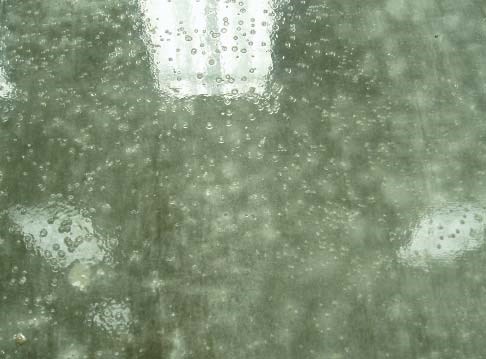Concrete sealer problems can be a source of frustration for concrete contractors. When a concrete sealer does not look or perform as expected, the cause can usually be traced back to over-application, application in non-ideal conditions or a buildup of multiple coats. Following are five common sealer issues that contractors may face, why they happen, and how to avoid them.
Problem #1: Sealer bubbled

The presence of bubbles the sealer is usually caused by a heavy application. Outgassing from the concrete surface during sealer application should be free to quickly move through a thin, wet sealer film. What is thin? At a typical coverage rate of 300 square feet per gallon, one coat of an acrylic concrete sealer should be about 5 mils thick when wet. When dry, the sealer is only about 2 mils thick. (For comparison, a sheet of copy paper is about 10 mils thick and a credit card is 120 mils thick.) When the sealer is applied too heavily, the air displaced through the surface can’t escape, and it forms a bubble in the sealer surface.
Bubbling of a sealer can also occur if application is done in hot weather, or if the concrete is in direct sun. In these conditions, the sealer will “skin over” and dry on the surface before all of the solvent has evaporated. The pressure of the solvent trying to evaporate will form a bubble in the sealer surface. It’s best to apply sealers during the coolest part of the day when concrete is not in direct sun.
Problem #2: Solvent based sealer turned white, is peeling or is flaking off
There are two key contributors to “blushing”, or whitening of a solvent based concrete sealer. The first is application to a concrete surface that is wet, or to fresh concrete that still contains bleed water. When this occurs, the sealer will not bond to the concrete surface but will instead float on a trapped film of water. The second cause of sealer blushing is applying it too thick. Heavy coats of sealer, or a buildup of sealer applied numerous times over the years, will cause moisture to become entrapped under the sealer and, in time, the sealer loses adhesion from the concrete. When this occurs, the trapped moisture and air under the debonded sealer has a refractive index such that the sealer appears white to the human eye. In time, the sealer will peel or flake off the surface. To avoid this problem, carefully follow the manufacturer’s recommendations regarding coverage rate and number of recommended coats.
Problem #3: Water-based sealer is white or powdery
The drying process of water based sealers is quite complicated and significantly affected by the temperature and humidity of the environment during application. Water based acrylic sealers dry by a process called coalescence in which the water and then the coalescing solvent evaporate and fuse together the acrylic particles to form the sealer film. If the temperature during application is too low or humidity is too high, the coalescing solvent will evaporate before the water does and the sealer will dry white or powdery because the latex particles did not fuse together before drying. Always find out what temperature and humidity conditions are required for successful application of a water based sealer.
Problem #4: Sealer is stained from oil, leaves, tires, fertilizer, etc.
The most common concrete sealers are manufactured with acrylic polymers that do not provide exceptional chemical or stain resistance to the concrete. For more durability and resistance to chemicals and staining, consider an epoxy or urethane coating system, and ensure that the coating is appropriate for exterior use before applying to outdoor concrete.
Problem #5: Concrete is dark and/or blotchy after sealer is applied
Most acrylic sealers will darken concrete and leave a glossy shine to some extent, giving the concrete a “wet look”. Because every slab is unique in its color and texture, the color of the concrete after sealer application is difficult to predict. The mix design, use of chemical admixtures, finishing techniques and porosity are just a few factors that will affect the concrete surface color. A sealer will deepen the true color of concrete and will highlight all the differences in the surface texture that result from floating and finishing. Sealers also bring out the “grain” in concrete just like a varnish does on wood. If changing the concrete color after sealing is a concern, use a penetrating water repellent sealer or do a small test application of a film-forming sealer to make sure the color change will be acceptable.
Want to learn more?
Watch our video - How To Apply Solvent Based Sealers
See our products - Curing & Sealing Compounds
 ABOUT JENNIFER CRISMAN
ABOUT JENNIFER CRISMAN
Jennifer Crisman is the Senior Product Marketing Manager for Construction Products at Euclid Chemical. Jennifer began her career at Euclid Chemical over 20 years ago in the R&D group, responsible for the formulation and testing of concrete coatings, sealers, adhesives and joint fillers. In her current role, Jennifer manages the marketing activities for these products as well as for Euclid’s concrete repair mortars, grouts, and waterproofing systems. She is a member of ASTM International subcommittee on Concrete Curing, as well as ACI technical committees on Curing Concrete, Repair of Concrete, and Decorative Concrete. Jennifer holds Bachelor of Chemical Engineering and Master of Business Administration degrees from Cleveland State University.